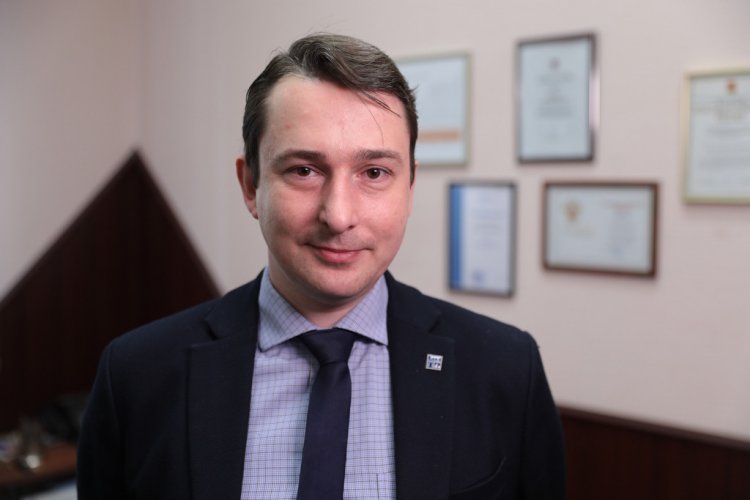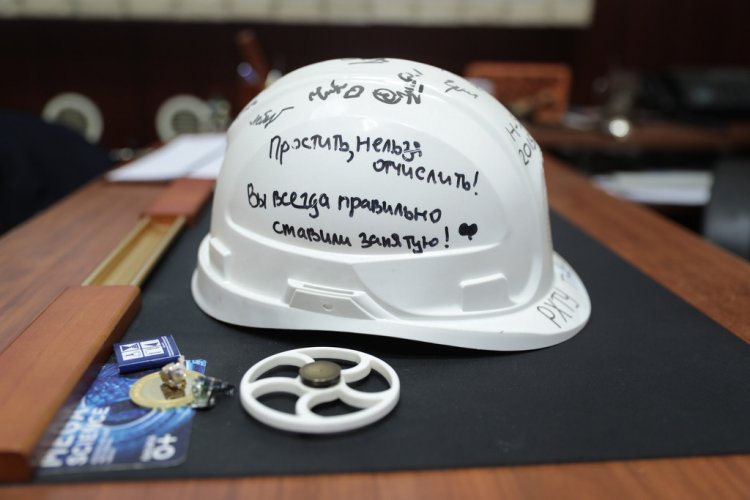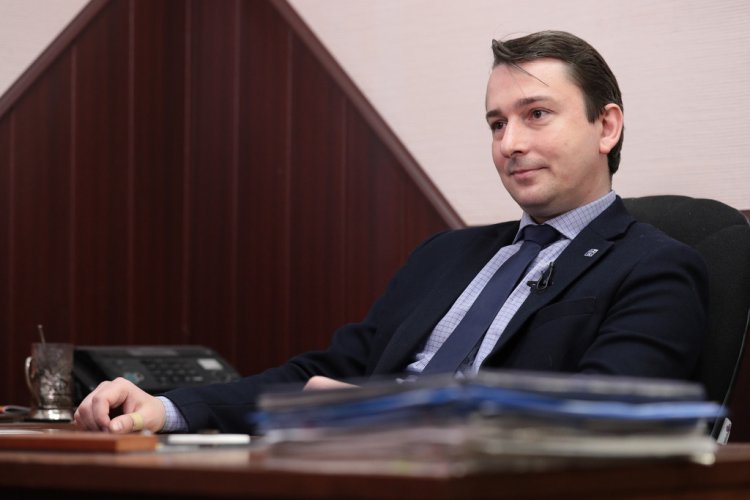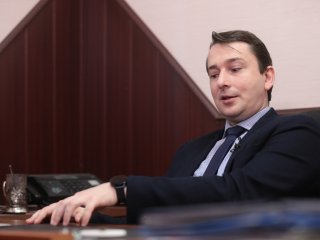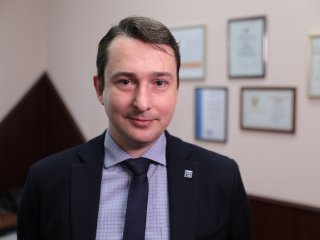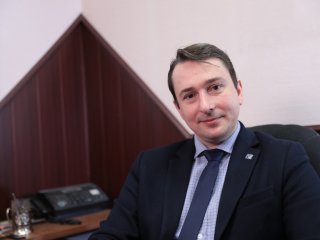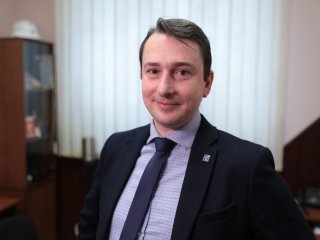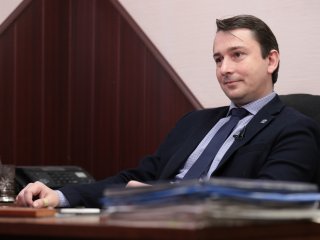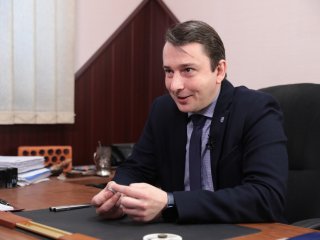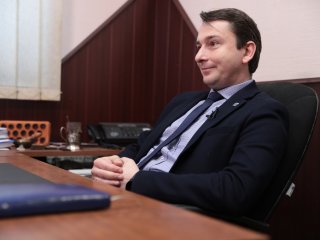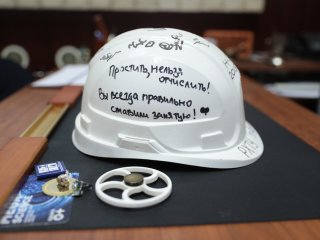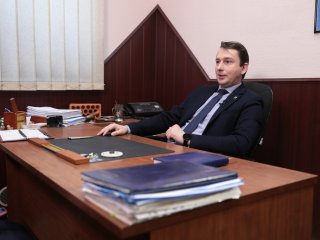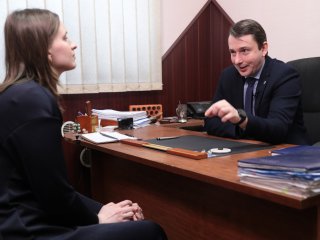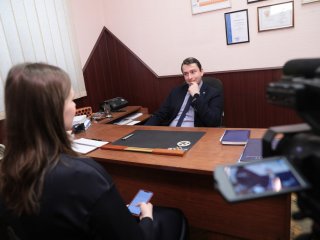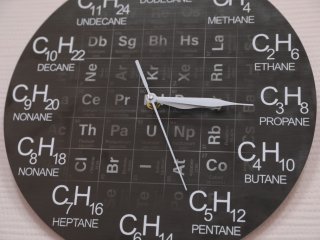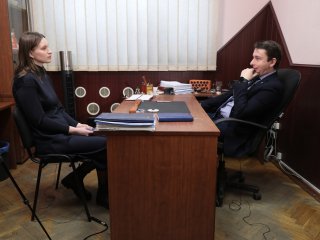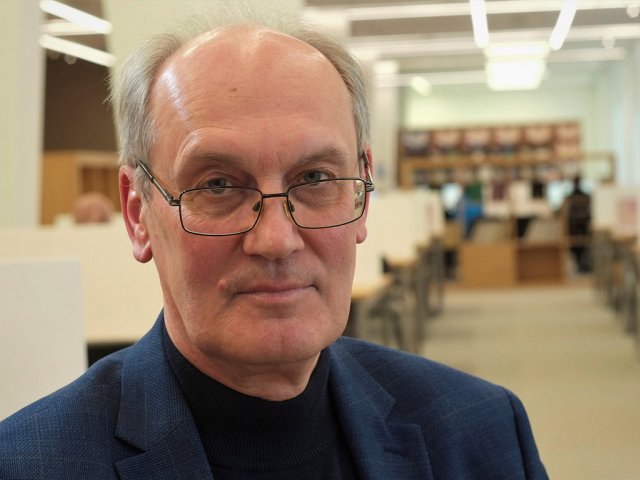We are used to seeing ceramics in the form of crockery on the tables and flower pots. But this material has many applications. Ceramics can be used to produce decorations and ornaments, building materials, such as facing tiles and bricks, porcelain and stoneware, cutting tools, parts of chemical and metallurgical equipment, seals of pumps operated in abrasion conditions and even engine and rocket components. All thanks to unique properties of ceramic materials. Ceramics has a high melting temperature, hardness and elasticity. Dmitry Lemeshev, Dean of the Faculty of Inorganic Substances and High-Temperature Materials Technology, talks about uses of ceramic materials in more detail.
Dmitry Olegovich Lemeshev is a Cand. Sc. in Engineering, Dean of the Faculty of Inorganic Substances and High-Temperature Materials Technology at D.I. Mendeleev University of Chemical Technology of Russia.
— First of all, I want to talk about ceramics. When an ordinary person hears the word, he or she most likely imagines crockery, probably flower pots or brickwork at best. What does ceramics mean to chemists?
— Ceramics is one of the oldest materials in the human service. On the other hand, this is a state-of-the-art material, which helps solve many material engineering problems, get properties unavailable to composite materials, metals or plastics.
It’s a matter of the unique structure of ceramic materials, their polycrystalline structure. That’s why, today, ceramics is an extensive class of materials varying from the most elementary ones, such as clays, from which we make bricks, roofing tiles, crockery and so on, to the most complex materials based on carbides, borides, oxides of rare earth and refractory metals, which allow us to be at the forefront of materials research.
— You said that ceramics has a special polycrystalline structure. What does it mean?
— Ceramics consists of tiniest particles, grains, which are tightly bound together by heat treatment thanks to the sintering process — mainly liquid- or solid-phase sintering. This builds a high strength of bonds between particles, which defines properties of ceramics.
In fact, ceramics and metals are close to each other by structure. For example, metals can also be polycrystalline and differ by composition and structure. But their fundamental difference is how crystals are formed or grow. If metals are usually subject to crystallization by screw dislocation, ceramic crystals employ the so-called edge dislocation when an extra plane of atoms is introduced. This defines its unique properties. Ceramics can be both strong and occasionally elastic. And most importantly, researchers and process engineers can embed necessary properties in the material thanks to the chain of composition — structure — properties.
Therefore, today, ceramics is a truly unique material that keeps on advancing the mankind towards progress, new technologies.
— And when did chemists pay attention to it?
— I think, it was back then when there were no chemists as such. There were the forefathers of the modern chemists — alchemists who tried to crack the secret of porcelain, still a unique material then, which only Chinese could manufacture. And it was worth more than gold.
European alchemists had been wrestling with its formula, properties, and structure for a long time. It was there that the basics of understanding of what ceramics was and how to work with it emerged. For instance, Johann Friedrich Böttger, a German court alchemist, worked hard to determine the necessary composition of the hard porcelain mixture. He discovered a method of heat treatment of clay to obtain a compact caked body. Böttger realized that mixing white clay, also known as kaolin, with sand provides a porcelain body, which can be used to mold and create expensive crockery.
The ideas of ceramics appeared when people started building houses. If you delve through a Roman library, I think, you can most certainly find a clay tablet, describing the process of making bricks, from which Romans built their structures. Scientifically, everything started with the Ceramics by A.I. Avgustinik, which was published in the middle of the last century. If we talk about the University of Chemical Technology of Russia, in 1923, the Moscow Industrial College became a technical college, which led to formation of two chairs — a Chair of Inorganic Substances Technology and a Chair of General Chemistry. Established in 1933, the Faculty of Chemical Technology of Silicates dealt with development of ceramics, glass and cementing materials. Therefore, it’s almost 100 years that our university has been researching it.
— What are the modern uses of ceramics?
— At the lecture, I play a game with my students — they are supposed to give me an example of at least a single industry not using ceramics. From iron and steel industry to aviation, space industry, nuclear and thermonuclear physics, ceramics is used everywhere.
For the record, there is even optically transparent ceramics, which is used, for example, in the development of solid lasers. Such lasers are used to confine a mixture of deuterium and tritium and start a controlled thermonuclear fusion.
— Can you tell us about other types of high-temperature materials?
— The academic community distinguishes several types of inorganic materials capable of working at high temperatures. Among them are cementing and composite cementing materials. The most obvious example is common cement used in construction. But there are also composite, aluminum-magnesium, aluminate cements, working at temperatures of around 1700°C-1800°C. For example, they are used to fix tiles for thermal protection of spacecrafts and space capsules.
Another example is glasses, both common glasses used in construction and special high-refractive-index glasses used as lenses, capacity windows, etc.
Besides, there is the so-called Sitall, a crystalline glass, having a set of unique properties. Or Astrositall, which virtually has a zero thermal coefficient of linear expansion and is used as a substrate for telescope mirrors. In astronomy, the precise geometry of mirrors is paramount, as any change in temperature will deform the material. Therefore, high-temperature materials are so widely used in this industry. And it should not go unspoken about traditional ceramics, which is also used at temperatures of 100°C to 3000°C.
A memento from grateful students
—In April, we recalled the achievements of the Russian cosmonautics, rocket science and aircraft industry as part of the Year of Science and Technology in Russia. What can researchers working with new high-temperature materials offer here?
— The scientists who develop new ceramic materials have already come up with a proposal, for example, for hypersonic rocket systems. A while ago, there was a true tech race between Russian and foreign scientists, seeking to assert themselves as the first to create a material for an inlet lip of such vehicles. Because the higher the speed the higher the heat on the inlet lip. The Russian colleagues created a material, which is resistant to loads, occurring at hypersonic velocities of over Mach 8-10. Today, the task that faces us is to make an even more resistant material in order to considerably increase the flight speed.
Speaking of the civil applications, the Russian specialists build engines for the MC-21 airliner. This is a line of the state-of-the-art engines, the building of which cannot proceed without ceramic and composite materials. In general, trends in development of gas turbine engines are intended to increase the number of composite, as well as ceramic materials.
Therefore, the scientists of today stay ahead, as they use components, assemblies, materials with the properties that will be highly employable in a few years and even decades. This is the main challenge for material scientists — to develop not only a material but also a technology for getting this material, which would provide a competitive advantage for several decades to come.
— Does the government take an interest in such technologies?
— Of course. It is not so much a question of independence as of the viability of our nation. We can talk about good neighbor relations, friendship with every partner as much as we want, but we need to think about protection of our citizens in the first place. This is why many specialists are working on a set of safeguards, including the rocket technologies.
And it is no secret that all new technologies come from the defense industry. All the developments related to high-temperature materials are mainly intended for the defense industry. But in a few years, they will “descend” into the civilian sector, which will further sparkle an interest of scientists who are currently dealing with other materials science tasks.
— Speaking of cosmonautics, can ceramics solve the radiation exposure problem?
— There is special-purpose ceramics for nuclear facilities. It employs other oxides, anoxic compounds, etc. Let me emphasize that scientists, creating new materials, always develop a material with specific applications in mind. If we are tasked with creating a material resistant to radiation, capable of working in high neutron fields, with ionizing radiation, such properties will immediately be embedded in the material structure.
But that is not to say that ceramics intended for the nuclear industry will work well in cosmonautics. In this case, materials with necessary properties are developed separately.
— What advanced materials are in highest demand today?
— In fact, there are no versatile materials. There are materials, which are created to solve a specific task. And the choice is always between the functionality of a material, ease of its fabrication and, regrettably, the cost of such material. We can create ceramics, which will have any property. But the question is whether it will be in demand.
Let us say, we will create super hard and super strong ceramics, which will resist any impact by a kinetic body. You’d think that such ceramics can be used to build a jet, which will never crash. But the cost of such ceramics will be simply unprecedented. It is much easier to use other, lighter materials, for example, composite materials based on carbon and titanium fibers. It is exactly where aviation technologies, in which most metallic panels are replaced with composite ones, are heading.
Globally, the future of materials science belongs to composite materials. Because only these materials can combine the strength of metals and lightness of plastics.
— How are advanced materials created? What tools do materials scientists use?
— In addition to a large amount of literature data, which our colleagues and us publish, there are software systems for development and evaluation of the material property structure. First of all, it is necessary to define a problem correctly — to understand all conditions, under which the material will work, whether that be ceramics, a composite or constructional material. It is important to determine all the factors, which will influence this material. With uses and influencing factors determined, we extrapolate these factors on the properties of materials. Let us say, a material is expected to stand a sudden heating from -50°C to 1000°C. So, we need to ensure that the material is highly heat-resistant.
Having learnt properties, we define the material structure. And at the stage of its formation, specialists embed the listed properties and factors, which influence the material and primary components, from which the material will be created.
— What devices are used for it?
— For example, profilometers and atomic-force microscopes are used to study the surface structure. But the studies of the internal structure of materials require electron microscopy — transmission and scanning microscopy, as well as tunnel and atomic-force microscopes. Like I say, there are many options. From elementary tools, such as analytical balance, to complex ones, for instance, X-ray fluorescence spectrometers.
— What studies on the subject does the University of Chemical Technology of Russia carry out? Do you engage students and postdoctoral researchers to do the job?
— Of course. For example, almost all chairs of our faculty work with new materials, including the ones for aviation and cosmonautics. These can be glasses for air ports or optical devices, ceramic materials for thermal protection or for bearings, lips, high-temperature cementing materials intended to work at high temperatures, microelectronic elements, which are used in aviation, cosmonautics, crystals, which are used as substrates and end products of micro- and nanoelectronics.
Today, we actively cooperate with the Roscosmos State Corporation. Some chairs have close contacts with the All-Russia Institute of Aviation Materials (VIAM), one of the leading institutes developing aircraft materials. Many UCTR graduates work at VIAM. We support them in every possible way, as this work is an important contribution to real technologies and materials, which are much-needed and used in development of state-of-the-art engines. It seems right to me.
— How much interest do young people show towards such technologies and new materials?
— I guess, there is a big interest, especially in the aviation and space industries, the most romantic applications of new materials. In childhood, everyone dreams of standing next to a big rocket or an airplane if not being a cosmonaut. Therefore, the interest towards this industry is truly high. Especially since Russia is one of the leaders in cosmonautics, aircraft industry and rocket science.
— How fast does the educational part change? Are there any new academic disciplines and programs?
— Today, education is a very dynamic sphere. At UCTR, we do our best to offer students knowledge to solve specific tasks in the industry they have chosen. There is a certain step-like basis. Under the bachelor’s program, a student receives general knowledge, that is, a foundation to develop further career.
But the most concentrated and application-specific knowledge comes with the master’s program. Every year, we are trying to streamline its curriculum, review and revisit existing disciplines.
And, of course, it is important to work with corporations and businesses that ensure operation of any industries. Thanks to practice, businesses can renew the staff and students can go deeper into professional topics.
— When and why did you take interest in the topic?
— I entered UCTR, because my entire family graduated from this university’s Chair of Chemical Technology of Ceramics and Fire-Resistant Materials. I am the third generation of chemists in my family, which is why there was not much of a choice, as the chair had been chosen even before I was born, in a manner of speaking.
When it came to choosing a topic, I tried to understand what ceramics was like and where it was used. Having read lots of articles and books, I realized that ceramics was present virtually everywhere. However, a certain class of materials captured my interest. It was an ultimate expression of ceramics — optically transparent ceramic materials. Today, they are used in different industries, but earlier, they were applied in laser equipment and nuclear industry.
It made me wonder how transparent ceramics was created. This determined the choice of my subject and thesis advisor and in the future — my scientific fate for the next 5 to 7 years.
Back at the time, UCTR had strong scholarly traditions established by Yevgeny Stepanovich Lukin, Dr. Sc. in Engineering, who was one of the first scientists in our country to start development of optically transparent ceramics and successfully worked on this task. It is under his supervision that I defended my Cand. Sc. thesis.
Later, I continued to work on this topic, which eventually led to the technology of obtaining transparent ceramic materials, an achievement for which in 2019, I scooped the Moscow City Government award granted to postdoctoral researchers for the aerospace engineering work.
— What would you wish for the young people, students who have just embarked on this journey? What types of new materials should they pay special attention to?
— I would like to wish them to keep going. Everything is simple. The person evolves when he or she goes somewhere.
And, of course, they should not be afraid to take their lumps, as they try to open the doors that seem to be open, but in fact they are closed. When we embark on a journey, we have a choice. We can often hear that a university graduate has all doors open before them, which is not exactly true. Doors are closed as a rule. But you should not be afraid to knock on this door. You should not be afraid that the doors won’t open. You might want to knock harder or try a different door.
As for the choice of research areas, you should always remember that science develops rapidly. An observation of computational technologies suggesting that their capacity doubles every 10 years is also true for any other industry. Technologies are changing, they are dynamic.
But the main thing is that the word “technology” has the root “logos” meaning “science.” Any technology is not just any abstract thing. It is really a science, which develops rapidly. Therefore, I would wish young researchers to do what they are interested in, what they see as their future. The scientist’s intuition means a lot.
But there should always be a drop of success, as intuition without success is useless.
Interview sponsored by the Ministry of Science and Higher Education and the Russian Academy of Sciences.
